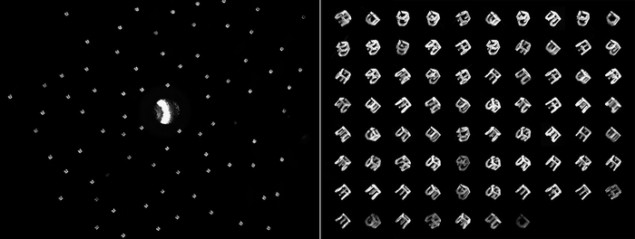Multiple mirrors magnify atom interferometry
20 Oct 2022 Isabelle Dumé
Various views of a 3D-printed object captured by a single camera. (Courtesy: Sanha Cheong/SLAC National Accelerator Laboratory)
A new multiple-mirror imaging technique could greatly improve the performance of atom interferometers, making them more useful in applications ranging from dark matter detection to quality control in manufacturing. By capturing incoming light from many different angles, the new technique enables scientists to collect more light than is possible using conventional imaging set-ups, boosting the system’s sensitivity.
The new technique, which was developed by researchers at the US Department of Energy’s SLAC National Accelerator Laboratory, is an example of light-field imaging, which captures not just the intensity of light, but also the direction in which light rays travel. The multiple mirrors redirect the different light views and overlap them onto an imaging sensor. This light field information can then be used to reconstruct a three-dimensional image of an object.
Gravitational searches for dark matter
One possible use for the new technique would be in the Matter-wave Atomic Gradiometer Interferometric Sensor, a 100-metre-long atom interferometer currently being installed at the Fermi National Accelerator Laboratory in Illinois, US. MAGIS-100, as it is known, will be a new tool in the ongoing search for dark matter – the mysterious substance that is thought to make up 85% of the matter in the universe but is currently only observable through its gravitational influence, which prevents large objects such as galaxies from flying apart as they rotate.
In MAGIS-100, researchers will release clouds of strontium atoms in a vacuum tube and then shine laser light on the clouds to image them as they fall within the tube. Each atom acts like a wave and the laser light puts these atomic waves into a superposition of quantum states: one state in which the atom continues down its original path and another in which the light “kicks” it higher up the tube. The two waves then recombine, creating an interference pattern. The relative distance between the pairs of quantum waves is highly sensitive to perturbations and could thus reveal the hidden influence of dark matter.
For this technique to work, however, the laser light needs to be just the right intensity. Too intense, and it will destroy the structure of the atom clouds; not intense enough, and the clouds will be too dim to be picked up by the experiment’s imaging camera (which sits outside the chamber that holds the atoms). One solution to this problem would be to use a camera with a wider aperture, but this would create a narrow depth of field in which only a small part of the image is in focus.
Capturing more light
In the new work, the team led by Murtaza Safdari of Stanford University in the US overcame this problem by reflecting light travelling away from the cloud back into the camera lens. The camera can then gather not just more light, but also more views of an object from different angles, each of which shows up on the image as a distinct spot on a black background. A collection of such distinct images can be used to reconstruct a 3D model of the atom cloud.READ MORE

“Conventional imaging captures only as much light as the lens aperture can accept, and it necessarily loses directional information since it integrates light over the aperture of the lens,” Safdari tells Physics World. “Conventional spatially multiplexed light field imaging is also hampered by the limited lens aperture. Our system is able to benefit from the 3D information capturing ability of spatially multiplexed systems, while also capturing more light than the lens’ aperture would conventionally allow.”
Safdari adds that while the system would directly benefit imaging in atom interferometer experiments like MAGIS-100, it could also have other applications, such as parts inspection on production lines and particle tracking. He and his colleagues are now adapting their design concept to take images of atom clouds in a magneto-optical trap at Stanford, while in the longer term they would like to develop an in-vacuum version of the system to install at MAGIS-100.
The present work is detailed in the Journal of Instrumentation.

Isabelle Dumé is a contributing editor to Physics World.
FROM PHYSICSWORLD.COM 20/10/2022

Δεν υπάρχουν σχόλια:
Δημοσίευση σχολίου